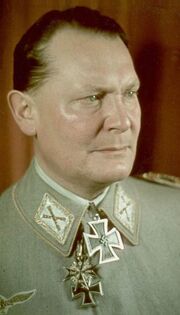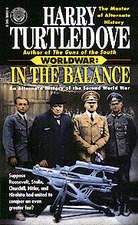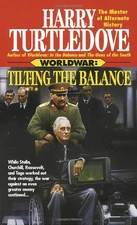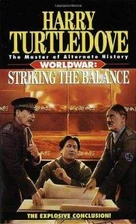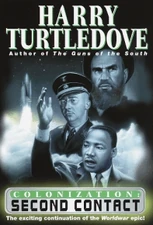| ||||||||||||||||||||||||||||||||||||||||||||||||||||||||||
Hermann Wilhelm Göring (12 January 1893 – 15 October 1946) was a German politician and military leader, a leading member of the Nazi Party, second in command of the Third Reich, designated successor to Adolf Hitler, and commander of the Luftwaffe (German Air Force).
Following World War II, Göring was convicted of war crimes and crimes against humanity at the Nuremberg Trials. He was sentenced to death, but committed suicide the night before he was due to be hanged.
Hermann Göring in The Man With the Iron Heart
Hermann Göring was one of several German officials who was captured by the Allies at the end of World War II.[1] The Allies sought to try Goering and the other men for war crimes. These plans were stopped twice by the German Freedom Front, first in November, 1945 when the GFF destroyed the Palace of Justice in Nuremberg[2] and second in 1946, when the GFF destroyed the American residency zone in Frankfurt with a radium bomb.[3]
In 1947, the Soviets decided to try the officials in their zone. The GFF prevented this by crashing a plane into the courthouse, killing all the lawyers and judges, but leaving Göring and his fellow accused unharmed.
Hermann Göring in In the Presence of Mine Enemies
Hermann Göring (1893-c. 1961) was the only person to hold the title Reichsmarschall of the Greater German Reich. However, his role in the early Reich was so dominant that the Air and Space Ministry was still known as the Reichsmarschall's Office in 2010, almost 50 years after his death. The roof of the Ministry was covered in elaborate gardens and grass, as a venue for his notorious orgies.[4]
Göring had been Adolf Hitler's hand-picked successor. However, Göring died before Hitler, and so Heinrich Himmler became the second Führer of the German Reich.[5]
Rolf Stolle, the Gauleiter of Berlin, had developed a reputation for debauchery that nearly matched Göring's own.[6]
Hermann Göring in Worldwar
Hermann Göring (1893-c. 1960) commanded the German Luftwaffe during World War II and the war against the Race's Conquest Fleet. At one point, he was Adolf Hitler's presumed successor as Führer-Chancellor, but he had disgraced himself publicly, and Heinrich Himmler succeeded Hitler.[7] Although something of a joke after his death,[8] Göring was still sufficiently esteemed in the Reich that the Reich Rocket Force named its first atomic-powered spaceship the Hermann Göring in the Reichsmarschall's honor.[9] That ship was destroyed in the Race-German War of 1965.
Hermann Göring in The War That Came Early
Hermann Göring was a prominent member of Nazi Germany's government before and during the Second World War.
Göring was present for the Munich Conference in September 1938. While Göring was loyal to Adolf Hitler, he did express some doubts about Hitler's decision to attack Czechoslovakia in response to the assassination of Konrad Henlein.[10] Nonetheless, his Luftwaffe received its trial by fire over the next months.
Despite the trials of the war, Göring publicly carried on as if the situation on the continent was normal. He attended a performance of Tannhäuser at the Staatsoper in 1939, for example.[11] He also made sure his own creature comforts and voracious appetites were not adversely affected by the inevitable shortages the war produced.[12]
Göring held his position until 1944. After Hitler declared war on the United States in March 1944, the Committee for the Salvation of the German Nation decided the war was unwinnable and took action.[13] When Hitler gave a broadcast speech in Münster about the insurrection taking place there, a bomb was planted which exploded, killing him. Immediately the Committee took over the radio broadcast and their leader Heinz Guderian announced Hitler's death and that the Committee was taking over. He also announced the imminent arrest of Göring, along with other members of the Nazi Party.[14] Göring vanished during the subsequent civil war, and remained unaccounted for into the summer of 1944.[15] Some rumors had it that he had been killed, others insisted he was still at large.
Literary comment
Göring's fate remains a mystery at the series' end.
See also
- Hermann Goering at the Riverworld wiki
References
- ↑ The Man With the Iron Heart, pg. 108.
- ↑ Ibid., pg. 112-113.
- ↑ Ibid., pg. 261-262.
- ↑ In the Presence of Mine Enemies, pg. 4.
- ↑ Ibid., pg 5. "The Reichsmarschall was almost fifty years dead" in 2010.
- ↑ Ibid., pg. 277.
- ↑ Second Contact, pg. 562.
- ↑ Down to Earth, pg. 338
- ↑ Ibid.
- ↑ Hitler's War, pg. 17
- ↑ West and East. pg. 102
- ↑ See, e.g., The Big Switch, pg. 273.
- ↑ Last Orders, pgs. 300, 311, HC.
- ↑ Ibid, pgs. 299-300.
- ↑ Ibid, pg. 326.
| Titles and Succession | ||||||||||||||||||||||||
|---|---|---|---|---|---|---|---|---|---|---|---|---|---|---|---|---|---|---|---|---|---|---|---|---|
| ||||||||||||||||||||||||
| |||||||||||||||||||||||||||||||||||||||||||||||||||||||||||||||||||||||||||||||||||||||||
